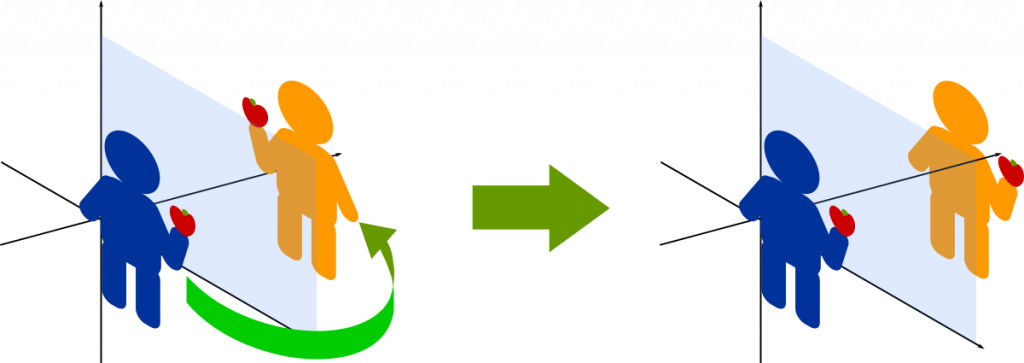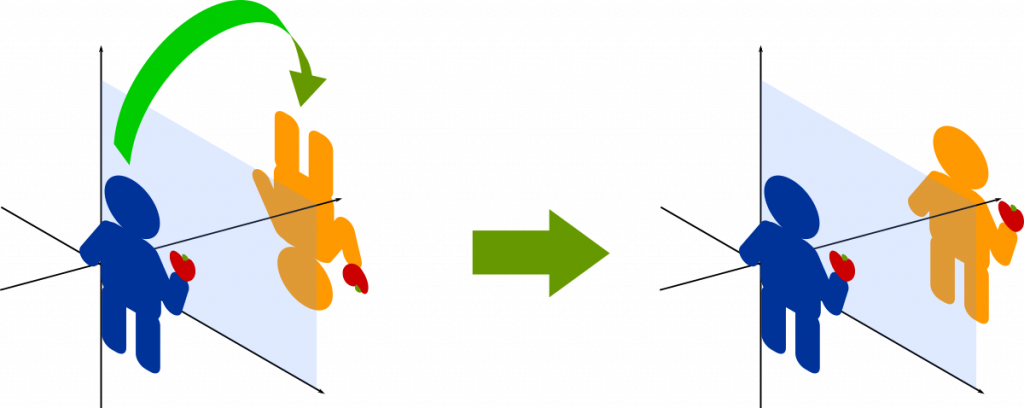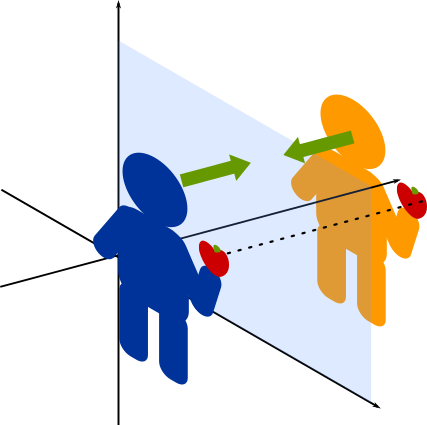Why are mirrors opposite left and right, but not upside down? Actually, it’s neither.
When you stand in front of a mirror and look at your reflection, you might think that the person on the other side of the mirror is on the opposite right and left. However, why is the mirror opposite left and right, and not up and down? In order to understand why, we need to understand our cognitive habits.
When you imagine rotation, right and left appear to be opposite
When you look at yourself in front of the mirror, why do you think the left and right sides are opposite?
Let’s say you and another person stand facing each other, both holding an apple in their right hands.
However, the other person’s apple is on the left side as you look at it. But you would never think that the other person is holding the apple with his left hand. This is because, as shown in Figure 1, you have imagined a 180-degree turn and know that the person facing you is on the opposite left and right. Based on this knowledge, you think of yourself in the mirror as holding an apple in your left hand.
Thus, in your mind, you have reversed the right and left sides of the person standing across from you.

figure 1
Is it true that the left and right sides of the mirror are opposite? Actually, it does not.

figure 2
Now let’s change the direction of rotation as shown in Figure 2. If you do this, the people facing each other will be upside down. And if you turn the person standing on their head upside down, it will match the reflection in the mirror.
Your brain has corrected the difference between the right and left sides in Figure 1. In the same way, your brain corrects the difference between the top and bottom in Figure 2.
Therefore, we can say that our reflection in the mirror is the opposite of right and left, or the opposite of up and down. If our brain is correcting the image, then we should be able to correct it correctly in either case.
Are you convinced?
In fact, the front and back are opposite
However, you must not be convinced if you are told that both left and right and up and down are possible. How does the world on the other side of the mirror actually look like?
Now let’s consider this wonder using mathematical spatial coordinates as shown in Figure 3.

For example, an apple held in the right hand is located at (x,y,z)=(10,-5,7).
And the apple on the other side of the mirror is at (10,5,7).
The x-coordinate and z-coordinate are the same, but only the y-coordinate has the opposite sign. This is called x-axis symmetry.
Mathematically, it looks like this, but in simpler terms, it means that the front and back are swapped. In other words, your reflection in the mirror is not the opposite of left and right, up and down, but the opposite of front and back.
People perceive left and right as opposites based on experience
Now you know the answer, but you still perceive your reflection in the mirror as the opposite of right and left. Even if you understand the theory, the reason why you don’t see it that way has to do with the mechanism of the human brain.
We judge the situation in front of us based on the knowledge we have experienced since we were born. We are not very good at imagining what we have not experienced.
We can easily imagine Figure 1, but we can’t imagine Figure 2. In fact, we will probably never encounter such a situation.
We are not born knowing that the left and right sides of a person facing each other will be opposite. It is knowledge that comes from experience. And once we start to see the world based on that knowledge, we cannot see it any other way.
What you see based on your experience is not always right
Our brains try to choose the interpretation that is closest to our own experience among the several interpretations mentioned so far. That’s why we see the person on the other side of the mirror as being the opposite of right and left.
The reflection in the mirror is, to be precise, the replacement of the face and the back of the head, the stomach and the back, without rotation, which never exists in reality.
Mirrors are a very familiar part of our lives, but they teach us that even the things we see with our own eyes every day are not interpreted correctly, and that we see things incorrectly based on experience and subjectivity.
In conclusion, it is important to carefully review what we take for granted by using objective observation without being bound by experience.
Now are you convinced?
SNSでシェア